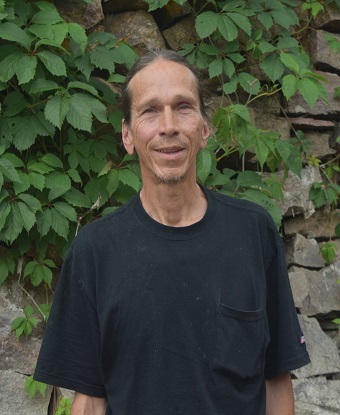Last updated: August 31, 2020
Person
Francis Eastman

NPS/J.Borden
Sisseton Wahpeton Oyate/
Northern Cheyenne Tribe
Francis Eastman, son of Emmett Eastman, was born in Breckenridge, Minnesota, on January 19, 1965. For the first half of his life, he grew up and lived in the Wahpeton area, just across from North Dakota’s Chahinkapa Park. As an adult, Francis briefly moved to both Minneapolis and California before eventually settling in the town of Pipestone, Minnesota.
Francis’s family had always had ties to the pipestone quarries, his father a member of the Sisseton Wahpeton Oyate and his mother being both Dakota and Northern Cheyenne (from the Lame Deer, Montana, area). Francis’s great-grandfather was David Eastman, brother of the renowned author and physician Charles A. Eastman. Both of Francis’s grandfathers learned the arts of pipe carving (and other pipestone craftworks) from an early employee at Pipestone National Monument.
Francis’s direct relationship with the pipestone began just over ten years ago. This relationship strengthened when, approximately five years after he began working the stone, Francis fasted as part of a traditional ceremony and dreamt of quarrying the precious íƞyaƞ ša (red stone). As part of this spiritual journey, Francis envisioned a quarry that could be used by the American Indian Movement (AIM) for the purposes of teaching younger generations the process of quarrying and carrying on these traditions. Upon discussing his ideas with staff at the Monument, Francis restored what was then an inactive quarry. This quarry is now known as the Sundance Quarry, and the stone pulled from this location is used for Sundance ceremonies that take place at the Monument each year.
Francis continues to quarry the stone regularly, and can often be seen helping others or assisting people new to quarrying. Francis believes that current (and future) pipestone quarriers and artisans should be proud of the legacy they represent, and he takes great pride in seeing the progress being made in the quarries. When asked what quarrying means to him, Francis responded “Belief and faith in the caƞnupa and how it helps me in life. [It is] the stone process evolving to the hands of the prayerful.”
When looking forward to the future of Pipestone National Monument, Francis believes that compromise and teaching will be the pillars of future management of the quarries. “Showing our tribes and society the pipemakers and quarriers helped save the stone and its history in the past and can do so in the future.”
